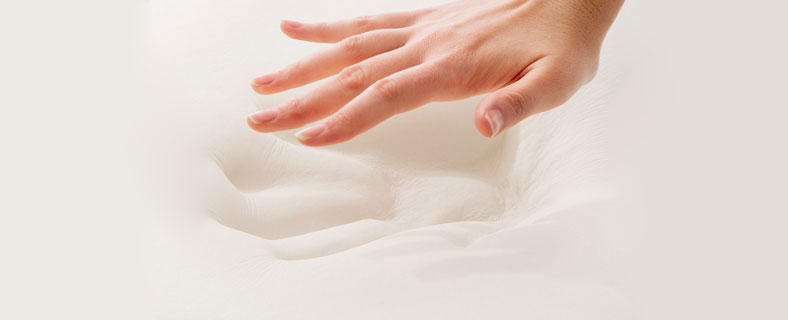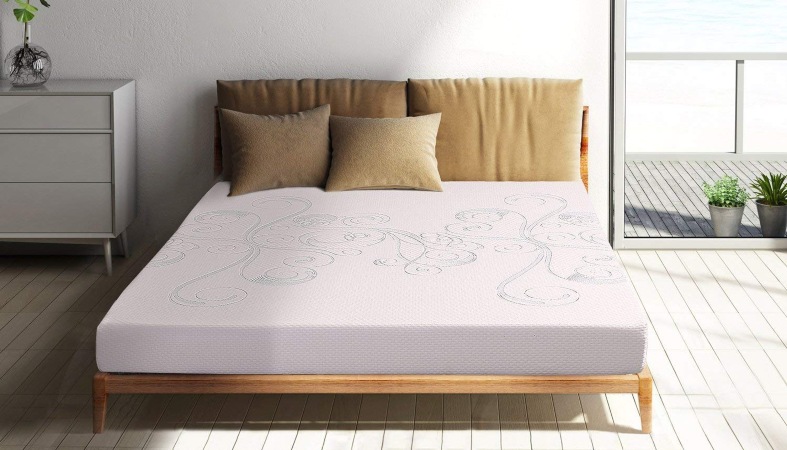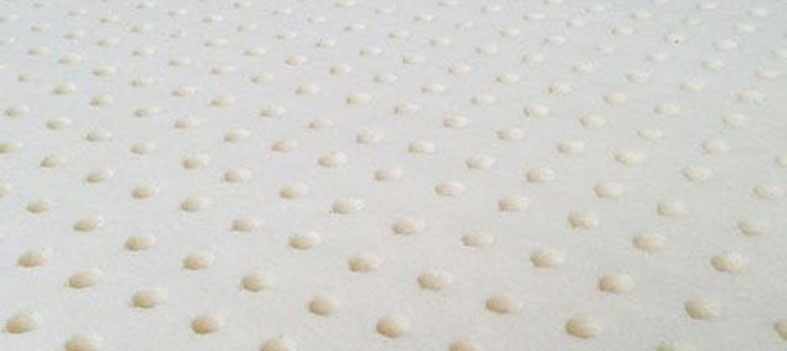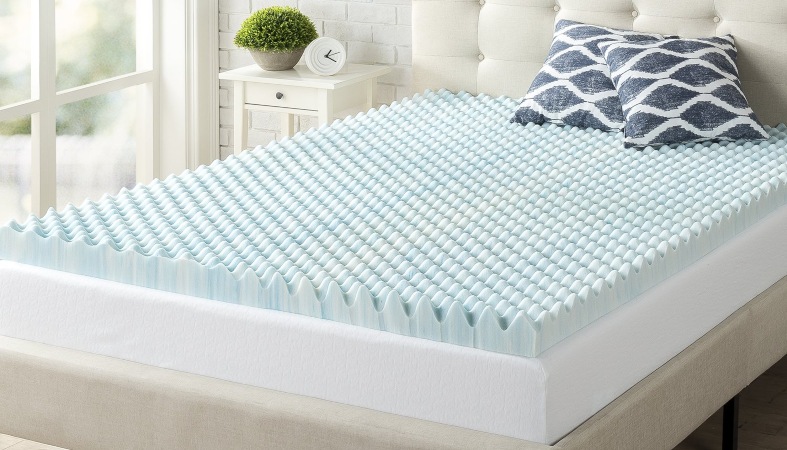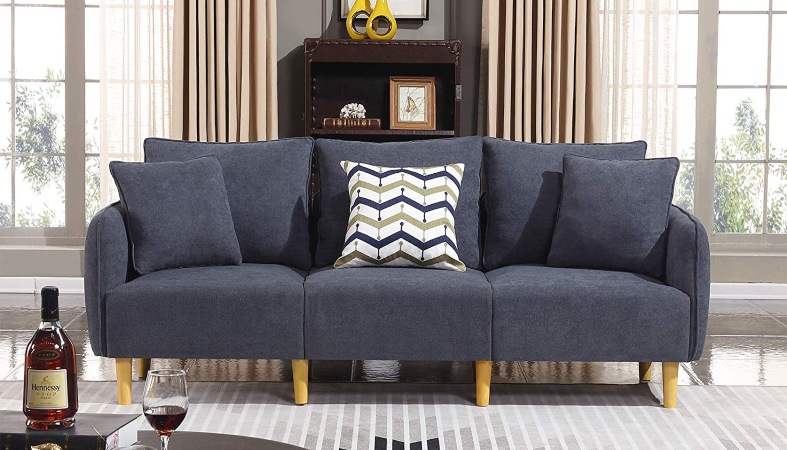When shopping for a mattress, or any sleep accessory for that matter, you will probably come across foam sooner or later. Memory, latex, polyfoam—with all the choices around, how do you know which one to pick? There are quite a few foams available and widely used in the sleep industry, but what will actually work best for you and your individual sleep needs?
Let’s check out the types of foam out there, and chat about some things you might consider when looking into your next purchase, like safety, cost, and durability.
Memory Foam
Memory foam, also called viscoelastic polyurethane foam, gets its name because it “remembers” your impression once you get up.
Different Types
Open Cell
This uses a bunch of small cells that essentially create air pockets to allow for better breathability. Because of this, it has a quicker response and bounces back faster than other types. Plant-based mattresses commonly use open-cell technology and also contain fewer volatile organic compounds (VOCs), so off-gassing that frequently comes along with memory foam can be lessened.
Traditional
What people generally think of when they think of this material, traditional memory foam has that extremely slow response that you sink into. When you push your hand down on the surface, the memory materials will show the print after releasing pressure.
Gel
There are a couple of ways memory combines with gel to create a cooler night’s sleep: gel can either be infused into it or a layer of gel is stacked on top or in between layers of foam. The gel is designed to wick away heat when you are warm and redistribute that body heat when you are cold.
Copper-Infused
Like open cell and gel, copper-infused materials are typically used to regulate temperature and combat the heat-trapping tendencies of memory materials. Companies that use copper often claim that it also has anti-inflammatory features and is hypoallergenic.
Find Out More: How Memory Foam Works
Pros
Memory materials conform to your body, so it tends to shine in its pressure relieving qualities. It performs well in alleviating back and neck pain and has that contouring feeling that many people find comfortable.
Companies have been taking advantage of the insulating nature of this product since the 1990s. For those who do not sleep alone, motion transfer can be a huge issue. Feeling your partner, pets, or kids get in and out of bed or move throughout the night can get in the way of sleeping soundly, but these materials excel in this category.
Cons
Because this material tends to be on the denser side, it often traps the heat that your body releases, so it can sometimes feel really warm. Many brands try to combat this by using gel, open-cell, or copper-infused technology, but for people who sleep really hot, it can be a problem.
Some like the feel of a traditional spring bed, but memory materials do not have much bounce, which might make repositioning in the night more difficult. It can also have an off-gassing smell when initially unpackaged, although it is harmless and will go away in a couple of days.
Polyurethane/”Polyfoam”
What is it?
Polyfoam is a popular, synthetic alternative that is made from petroleum. It is similar in makeup to memory foam, but it does not have the added chemicals that give memory materials that sinking, “melting” feel. Polyfoam is the most commonly used type, and you will often see it used in furniture and mattress pads.
It is measured in density, pounds per cubic foot (PCF). Generally speaking, the higher the PCF, the firmer the product, although that is not always the case.
Pros
Polyfoam is easy to find, and there is a wide variety of firmness levels that other types cannot provide. For those who are trying to save a buck, it often is inexpensive, which can be great for young adults who want to purchase their first mattress. It can be durable and bouncier than memory materials, so polyfoam is a great choice for those who are on the heavier side.
A common issue with foam is that it gets really hot, but the open structure of polyfoam helps keep the heat away.
Cons
Although it is often affordable, it can also sometimes be poorer in quality, meaning it might not last as long as other mattress materials. After some time, you may be able to notice some body impressions in cheaper brands, which can diminish the comfort it should provide.
Polyfoam does not have that contouring quality that other types may offer, so if you suffer from chronic pain, it might not give the support that you require. The average sleeper should not find this to be too much of a problem, though.
Latex (Rubber)
Latex is made from the sap of rubber trees, a more natural alternative to other materials. After extraction, it is poured into a mold and processed in two different ways. (Note there are synthetic latex blends that come from other sources.)
Different Types
Talalay
Talalay is a newer type that requires a few more steps in the process; the sap is poured into a mold but only halfway, then expanded and frozen. After freezing, the latex is baked, washed, and dried. It is a bouncier, lighter latex, and often has a more consistent feel.
Dunlop
Rather than only filling halfway, Dunlop processing fills the entire mold and then is vulcanized, washed thoroughly, and dried. It has fewer chemicals and is the most “natural” and eco-friendly. The feel is a bit denser and not quite as bouncy (but still bouncier than memory material).
Pros
Latex is one of the most popular mattress materials for many reasons. It is extremely durable; quality latex will last for decades. Both Dunlop and Talalay latex can be made with different levels of firmness, which is ideal for those who want a more customized bed for their specific sleep preferences.
The environmentally-conscious will be pleased by natural latex’s sustainability because it comes from natural resources and more often than not has fewer chemicals than other materials. Dunlop, in particular, takes far less energy to produce, making it the most eco-friendly.
Cons
High quality can come at a high cost, and natural latex tends to be more expensive than other types, especially Talalay because it takes a more involved process than Dunlop. Because it can last so long, however, many buyers find it to be worth the price tag.
It also has a distinct feel compared to other materials, as it is bouncier and has a quicker response, so if you prefer that classic sinking feeling, stick with memory materials. Although it is environmentally friendly, latex is not hypoallergenic, and those who suffer from severe latex allergies may not have a pleasant experience sleeping on this material.
Convoluted
Convoluted is also known as “egg crate” because it looks like, well, an egg crate—it has a bunch of little hills of foam in between deeper craters, where you could easily place an egg if you wanted to. You often see the egg crate design used in mattress toppers.
Pros
You should not have any problems finding convoluted mattress toppers both in store and online due to its affordable price and simple design. It works well to regulate temperature because of the varying heights within the surface allows airflow and can relieve pressure. For bedridden folks, it can help discourage bedsores because the skin may not be in constant contact with the material.
Cons
A downfall of this material is that it can prove difficult to clean. This can be combated by using a mattress protector and sheets, but if something happens to penetrate those layers, it can be problematic. Although those peaks can help alleviate pressure and encourage spine alignment, many will need better support underneath the convoluted foam, so those with softer mattresses may find themselves needing something firmer or more supportive.
Reflex
Reflex is a high-density polyfoam that is usually a medium firm. It has many similar features to memory foam, but rather than little holes, reflex uses bubbles that snap back into place much more quickly but still conform to the body’s natural curves.
Pros
Reflex is a great alternative to memory materials because it is much more affordable but still offers some of that contouring technology many seek. This helps with relieving pressure in the joints and keeping your body in line to discourage future aching. It is resistant to dust mites, which is a plus for asthma sufferers.
Cons
Although it contours to the body, reflex also tends to be firmer than memory, and while many can appreciate the support that the firmness brings, it may not provide quite as much relief to the back, hips, and shoulders. If you suffer from chronic pain, it might be best to spend the extra money on memory materials.
Evlon
Commonly used for couches on the nicer end, evlon foam is very firm, dense, and heavy. It weighs 2.2 pounds per cubic foot. Evlon has a really quick response and bounces back quickly, so it will not have that melting feeling you may feel from a viscoelastic material.
Pros
If you want a very firm mattress, Evlon might be the way to go. It is fairly affordable for the quality and durability and can hold up extremely well to heavier folks. Since it tends to be a common choice for higher-end sofas, it can handle a lot of abuse and still perform as intended.
Cons
Those looking for softer beds with loads of pain relief may need to look elsewhere; Evlon is not exactly designed for comfort in that aspect. Although it is inexpensive and should last a while, the dense nature might not be the best choice for the average sleeper. It is also difficult to move because of its weight.
Things to Keep in Mind…
Heat Retention
Foam is not the coolest material out there, especially memory. Although there are many things brands do to combat it, heat retention is still something that these types of materials tend to do. If you sleep warm but still want to have the benefits of foam, look for hybrid options or companies that are more specifically geared toward cooling elements.
Durability
Lower quality materials can break down quickly, meaning all that comforting support that it initially offers can diminish. Latex and higher density memory foams will perform best, especially when it comes to those who have an above average weight. Seek out beds that are also made with a spring system for an even more durable product.
Learn More: Durable Mattresses that Don’t Sag
Motion Isolation
Ever seen those commercials where a full glass of wine is placed on one side of the bed and a person is jumping on the other? If your sleep is being constantly interrupted because of restless partners, foam should promise many future undisturbed nights. Memory materials, in particular, excel in isolating motion and may be a light sleeper’s best bet.
Cost
Different types all vary in price, but in general, reflex, convoluted, Evlon, and polyfoam are on the cheaper end and latex and memory are on the more expensive side. This may differ depending on the quality, though, so be sure to do your research and check out reviews before purchasing.
Certifications
Certifications can give you a peek at the quality and safety of materials used in production. With foam, you will likely see “CertiPUR-US® Certified,” which is certification done by a third-party organization that tests for chemical levels and verifies its consumer and environmental safety.
Another certification is OEKO-TEX®, which looks at the foam (and other textiles) from all stages of production to assure its ecological safety.
GreenGuard Gold Certification has one of the most rigorous testing standards because it was originally intended to be testing for products used by the elderly and children. It assures that the mattress does not emit harmful chemicals.
Latex can be GOTS-certified organic, meaning the brand is made from certified natural materials. When shopping for more natural products, some companies may use the term “organic” to describe their mattresses; however, they are only truly organic when it has been properly certified.
These are likely the most common certificates you will see related to foam. To ensure the safety of you and your loved ones, it is important for you to be aware of the exact materials that your product is made from.
Lifespan
In this category, the rule “you get what you pay for” generally applies. High-density foams will often outlast lower density counterparts, but many will still have difficulties competing with innerspring beds that tend to have long lifespans. Latex will be your winner in this area, and if properly taken care of, it should last for decades.
Learn more: How Long Do Mattresses Last?
VOCs and Safety
Chemicals are used in the processing of foams, but there are varying levels of off-gassing that can occur once you unpack a new mattress, get a new car, buy furniture, etcetera. Essentially what happens is that some chemicals react when exposed to room temperature as the foam is expanding, which leads to the degradation of VOCs, also known as volatile organic compounds. It will often leave a strong odor for a maximum of a few days that airs out.
VOCs are not dangerous, but they can bother some consumers. If you fall under that category, look for safety certifications mentioned above and natural and plant-based materials to minimize off-gassing.
Frequently Asked Questions
What is foams for beds made of?
Mattresses are made from every type discussed here, with many brands using their personalized technology infused into the material. It is one of the most popular materials used in beds nowadays, so when purchasing, you will most likely see a wide range of foams that can fall under the categories mentioned above.
Conclusion
Feeling more like an industry “buzzword” than anything, the world of foam has gotten more confusing the longer it has been around. With all the varying types out there, it can be easy to get lost in what might suit your preferences best. Although each can differ, this material often excels in relieving pressure, conforming to the body and allowing you to rest in a natural position.
Now that you are armed with all this information, hopefully, you can get hyped up when looking to buy your next foam bed—or at least show off to your friends on everything you know.
Jill Zwarensteyn
Editor
About Author
Jill Zwarensteyn is the Editor for Sleep Advisor and a Certified Sleep Science Coach. She is enthusiastic about providing helpful and engaging information on all things sleep and wellness.
Combination Sleeper

